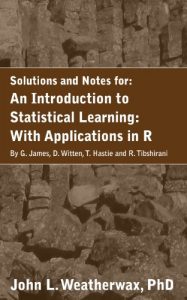This document has notes and solutions to the end of chapter problems from the book
An Introduction to Statistical Learning: with Applications in R
by Gareth James, Daniela Witten, Trevor Hastie, & Robert Tibshirani
This book is somewhat like an earlier book
The Elements of Statistical Learning: Data Mining, Inference, and Prediction
by Trevor Hastie, Robert Tibshirani, & Jerome Friedman
In that it discusses a number of modern methods for statistical learning. If there was any drawback to the earlier book it was that the examples were presented without algorithmic code to see how to duplicate them. At various locations on the web, people were able to reverse engineer the figures from the book and write code that duplicated many of the results. This might not have necessary since much much of the code for doing statistical machine learning has been standardized in R packages that make performing any given analysis easy to do. In ISL after each topic is introduced there are R labs that demonstrate how to use these libraries to implement the techniques discussed. The text shows actual R input and output on provided data sets. It is then easy to modify these labs to perform analysis on any data source that might be of interest, thus no tedious reverse engineering is needed!
In addition, at the end of each chapter are ``conceptual exercises'' and ``applied exercises''. In the conceptual exercises the reader is asked to reason about the techniques discussed in the chapter to ensure understanding of the presentation. In the applied exercises section the reader is asked to perform a more hands-on analysis using R and a number of provided data sets. This simulates the process one goes through when trying machine learning techniques on novel data sets. In this way, one gets a very applied view of machine learning: what to look for in a data set, how to apply various techniques, how to assess your algorithms performance, how to interpret your results, and what steps to take next.
An Introduction to Statistical Learning: with Applications in R
by Gareth James, Daniela Witten, Trevor Hastie, & Robert Tibshirani
This book is somewhat like an earlier book
The Elements of Statistical Learning: Data Mining, Inference, and Prediction
by Trevor Hastie, Robert Tibshirani, & Jerome Friedman
In that it discusses a number of modern methods for statistical learning. If there was any drawback to the earlier book it was that the examples were presented without algorithmic code to see how to duplicate them. At various locations on the web, people were able to reverse engineer the figures from the book and write code that duplicated many of the results. This might not have necessary since much much of the code for doing statistical machine learning has been standardized in R packages that make performing any given analysis easy to do. In ISL after each topic is introduced there are R labs that demonstrate how to use these libraries to implement the techniques discussed. The text shows actual R input and output on provided data sets. It is then easy to modify these labs to perform analysis on any data source that might be of interest, thus no tedious reverse engineering is needed!
In addition, at the end of each chapter are ``conceptual exercises'' and ``applied exercises''. In the conceptual exercises the reader is asked to reason about the techniques discussed in the chapter to ensure understanding of the presentation. In the applied exercises section the reader is asked to perform a more hands-on analysis using R and a number of provided data sets. This simulates the process one goes through when trying machine learning techniques on novel data sets. In this way, one gets a very applied view of machine learning: what to look for in a data set, how to apply various techniques, how to assess your algorithms performance, how to interpret your results, and what steps to take next.






